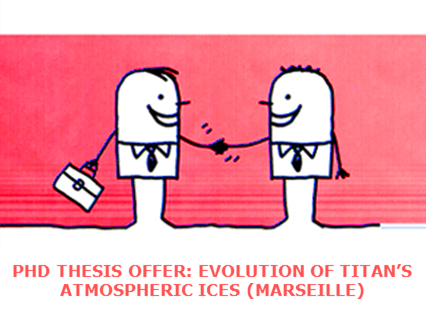Two years of post-doctoral position in GC-MS analysis – VAHIIA project
- Starting date : 2013/09
You hold a Ph.D. in analytical chemistry. Your area of expertise is GC-MS analyses. The aim of these researches will concern the analysis using GC-MS of volatiles coming from the heating of ices previously formed and irradiated (UV) at low temperatures (20K) and low pressure (10-8mbar). These experiments simulate the chemical evolution that could undergo the organic matter from the interstellar medium to its incorporation into comets or residues.
- Expected Gross Salary: 2361 € per month.
- Application must include: CV, motivation letter and two recommendation letters.
- End submission for applications: April 2013.
- Place: Groupe Astrochimie, Equipe Spectrométries et Dynamique Moléculaire, Physique des Interactions Ioniques et Moléculaires (UMR CNRS 6633 – Centre de St Jérôme, Aix Marseille University), Avenue Escadrille Normandie-Niémen, case courrier 252, 13397 Marseille Cedex 20, France.
Contacts:
Grégoire Danger Tel: +33 4.91.28.82.85
Thierry Chiavassa Tel: +33 4.91.28.91.94
Team website
Project abstract
The challenges of this project consist in simulating through laboratory experiments, the chemical evolution of interstellar ices and grains to understand the evolution of the organic matter during the life cycle of interstellar grains. Currently, our team is developing two complementary approaches to study this evolution. First, we are investigating the chemical reactivity that can occur within analogs of pristine or cometary ices, by working on small size systems (two or three reactants). Second, we are investigating the characterization of refractory residues formed during photolysis and warming of ice analogs without any degradation using an orbitrap apparatus. In this new project, we propose to develop a new approach, which consists in implementing an analytical system for the Volatile Analyses coming from the Heating of Interstellar Ice Analogs, the VAHIIA project. This new device will help us to get a better understanding of the chemical reactions that lead to the formation of refractory residues. It will also give crucial information on species that would sublimate during the warming of cometary nucleus. This system will consist in coupling to an ultra-high vacuum cryogenic system, a gas chromatography including a mass spectrometer in order to analyze volatile organic compounds sublimating during the heating of ice analogs. Therefore, the VAHIIA project will be the missing link between the two existing projects, and the whole will provide a comprehensive experimental approach aiming to trace the chemical history of such analogs by studying the reactivity of ice at low temperature, analyzing the volatile species sublimating during the warming, and characterizing the non-volatile residues resulting from the latter.
Scientific and Technical Objectives
Our objective is to understand the constitution and the chemical reactivity that occurs in interstellar ices during the life cycle of interstellar grains and that leads to the formation of refractory residues, similar residues supposedly carried by interstellar and/or cometary grains. The first step consists in simulating the formation of interstellar « primitive » ice as they are identified through astronomical observations. Once formed at low temperature (10 K) and low pressure (10-9 mbar), these analogs are subjected to various processes such as irradiation by ultraviolet photons (Lyman ) or atomic hydrogen bombardments. They may also be subjected to thermal processes to temperatures up to 800 K. This first step can be approximated to an activation step of molecules constituting these primitive ices, which is monitoring by in situ infrared spectroscopy. Infrared spectroscopy has the advantage of offering a direct connection with astronomical observations, making it a preferred method for analyzing the chemical composition of the solids in the interstellar medium. Once the volatile species are sublimated, the sample moves towards the formation of refractory residues (300 K in laboratory conditions). The understanding of the formation of refractory residues is an important step to establish what type of organic matter is available in interplanetary objects such as in comets or asteroids. For this purpose, we have starting collaboration with R. Thissen and V. Vuitton (IPAG, Grenoble) for very high resolution mass spectrometry analysis of these samples using LTQ-Orbitrap. During the warming of simple ice mixture (one to three reactants), low resolution mass spectroscopy (quadrupole) can be used for the analyses of sublimating-species in order to confirm infrared spectroscopy data. However, low resolution mass spectrometry is not efficient to identify the sublimated species coming from complex primitive ices, because for a same m/z several ions can be detected, and due to the saturation of the detection system caused by a large amount of material sublimating. Therefore, to analyze and characterize these species, it is necessary to develop an original analytical system allowing us to improve the resolution and the capacity of the analysis. This analytical system will consist in a gas chromatography-mass spectrometry apparatus, which will be directly connected to our cryogenic system in which ice is formed and warmed. The chromatographic column will provide the separation of analytes and the mass spectrometer will allow the identification of the molecular species and, if necessary, their structural analysis in order to confirm their identification. However, because desorption kinetics of sublimated species can be slow, the direct injection of these species in the chromatographic system is not feasible, since it would lead to low efficiencies. It is therefore necessary to have a device providing the pre-concentration of these species prior to their injection for analysis. Another adjustment required concerns the junction between the injector of the chromatographic system (atmospheric pressure) and our cryostat (low pressure). This system was developed in collaboration with Thermo Fisher Scientific instruments/Interscience.
Scientific importance of the VAHIIA project
Our objective is to understand the constitution and the chemical reactivity that occurs in interstellar ices during the life cycle of interstellar grains and that leads to the formation of refractory residues, suspected to be present into interstellar and/or cometary grains. The VAHIIA project will allow the characterization of the volatile species sublimating during the warming of ice analogs. The data obtained will be an essential step in understanding the chemical processes that can occur during evaporation of cometary ice mantle, as well as during the formation of refractory residues, which represent the bulk of organic matter available in planetary systems. Therefore, this project will have important implication in the science of laboratory simulation and for in situ analysis.






Aucun commentaire sur l'article Offre de Post-Doc Chimie Analytique à Marseille